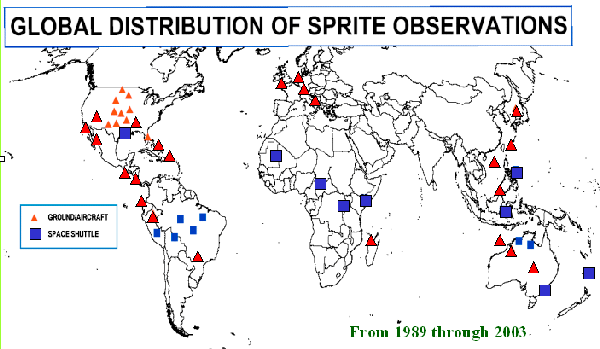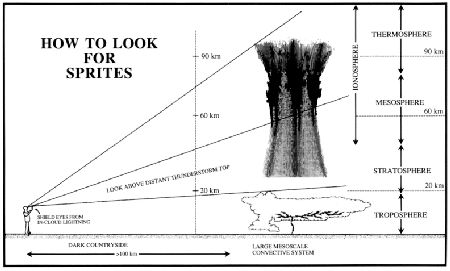Latest observations on sprites, jets and other phenomena
This section will be updated as new observations about sprites and related phenomena become available.
This will include new results from scientists as well as selected reports supplied by visitors to this site.
The map below is a representation of where various transient luminous events (sprites, blue jets, elves, etc)
have been reported. Over the central U.S., the number approaches 10,000 confirmed sightings. Thus the map is schemati

In Memory of the Crew of the Space Shuttle Columbia
Israeli Astronaut Ilan Ramon, one of the seven who perished in the tragedy of 1 February 2003, was conducting
a series of experiments onboard the STS-107 mission. One of these included obtaining calibrated images of sprites
and elves. Two images beamed back to Earth are shown below, along with a press story describing some of the
initial reactions. The detailed scientific analysis of these and other images will become part of the enduring
scientific legacy of the Columbia crew.

January 21, 2003
New York Times
Astronaut Captures Rare Images of Red Luminosities in the Skies
By REUTERS
CAPE CANAVERAL, Fla., Jan. 20 (Reuters) - Sprites and elves dancing on thunder clouds that were captured by
cameras on the space shuttle Columbia could help scientists crack the mystery of recently discovered
electrical phenomena that are usually invisible to the naked eye.
The sprites, which are red flashes of electricity shooting up from thunderclouds 13 miles into the ionosphere,
and elves, which are glowing red doughnut shapes radiating 190 miles, were photographed on Sunday by Capt.
David M. Brown of the Navy.
The shuttle and its crew of seven, including the first Israeli astronaut, Ilan Ramon, are on a 16-day science
mission that began on Thursday. The study of sprites is part of an Israeli experiment called the
Mediterranean-Israeli dust experiment, or Meidex.
This was the first time anyone had taken such images with a calibrated instrument from the shuttle, said Yoav Yair,
project coordinator for Israeli experiments on the Columbia mission, "and it´s causing really great excitement.
" Mr. Yair said Captain Brown did not see the luminosities or knew he had captured their images until scientists
on the ground downloaded the pictures and analyzed them.
"One has to be extremely lucky to catch because it lasts only 0.1 milliseconds - less than a thousandth of a second,
" Mr.Yair said. "Luckily, God was on our side this time, and we caught one."
The discovery of sprites in 1989 and elves in 1994 has opened up a new area of study in the field of upper atmospheric
physics. Until now, images of them have been limited to those taken from the ground or airplanes. The shuttle cameras
that captured the flashes are onboard primarily to help Meidex, which is designed to study the impact of dust particles
on global climate.
How to look for sprites

HOW TO LOOK FOR SPRITES, BLUE JETS AND UPWARD LIGHTNING
Whenever thunderstorms are around, it is possible, with a little luck, to spot a “transient luminous event” above the storm. Sometimes you might not even be looking intentionally, and it just happens. Below we summarize the basics of what to look for and how to interpret what you may have have seen.
Your reports are valuable. If you can provide enough detail, it can help researchers better understand the types of storms that produce these phenomena. And we are really, really interested in reports of upward discharges from thunderstorm tops such as blue jets and upward lightning. Also, “ball lightning” is a subject that is again gaining interest from the atmospheric electricty community. If you believe you have seen such a phenomenon, please let us know and we will forward your report to the appropriate researchers.
If you have obtained still images or video, then your observations would be especially valuable to helping advancing scientific study of these events
If you have an observation you wish to contribute to the growing base of reports from amatuers and professionals alike, click here.
General Rules: Most optical transients above thunderstorms are fairly dim (with the exception of upward lightning.)
So, once you have checked out the satellite and radar maps to locate storms within range of your location, the following will help improve your chances:
Moonless nights are preferred.
Rural locations far from urban light pollution are optimal.
Select nights with a minimum of haze, smoke or pollution in the atmosphere.
It is best to let your eyes become dark-adapted for five or ten minutes.
If the lightning from the storm system is visible, it may be best to block out their glare to enhance chances of seeing the dimmer features above.
Sometimes you have better luck by looking off to the side of the storm as you can see dimly illuminated objects better out of the corner of your eye.
Have a watch set to the second to obtain an accurate time for any event.
Listen to an AM radio (tuned to an unused frequency near the low end of the band). Sprites may coincide with unusual or strong bursts of static (called “sferics”)
Bring a chair, and perhaps something to support your head, while watching.
If you have a “night scope,” which are becoming increasingly inexpensive, use it. Many sprites show up very clearly even on older surplus units.

